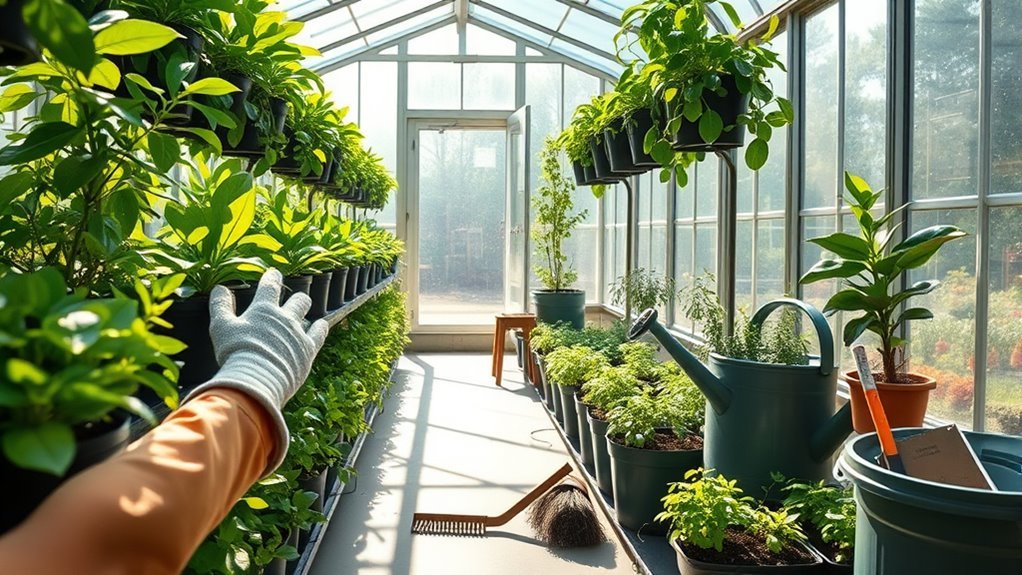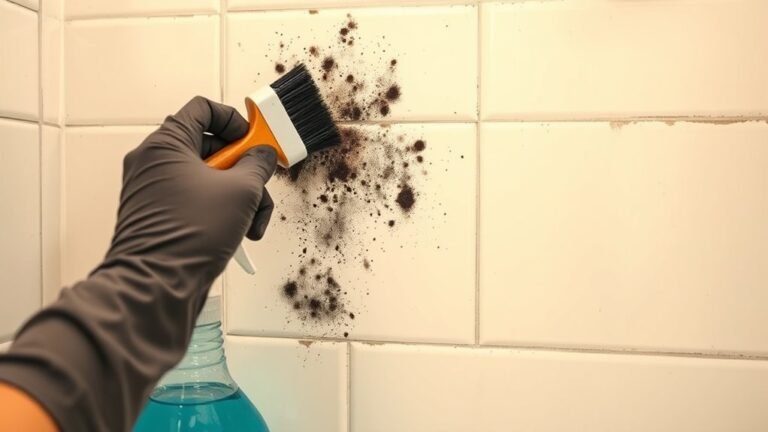Tips for Keeping a Greenhouse Clean and Functional
To keep your greenhouse clean and functional, stick to a regular cleaning schedule by wiping surfaces, removing debris, and sanitizing tools often. Verify proper ventilation with adjustable vents and exhaust fans to control humidity. Organize your tools and supplies neatly for easy access, and manage pests naturally using beneficial insects and organic treatments. Maintain efficient watering with drip irrigation and monitor your soil’s health consistently. These core habits will set the foundation for a thriving greenhouse environment, with plenty more helpful tips ahead.
Regular Cleaning Schedule

Although it might seem tedious, sticking to a regular cleaning schedule is vital for keeping your greenhouse healthy and productive. You’ll want to create a cleaning checklist that covers all key areas—floors, benches, tools, and plant containers—to guarantee nothing gets overlooked. Setting the right cleaning frequency is essential; some tasks should be done weekly, like wiping down surfaces and removing dead leaves, while deeper cleanings might only be necessary monthly or seasonally. This routine prevents pests and diseases from taking hold, giving your plants the freedom to thrive. By following a consistent schedule, you’ll save time in the long run and keep your greenhouse a clean, functional space where your gardening passion can truly flourish.
Proper Ventilation Techniques
Since air circulation directly affects plant health and growth, mastering proper ventilation techniques is essential for your greenhouse. Good airflow patterns prevent stagnant air, reduce mold risk, and help maintain ideal humidity control. You want fresh air moving freely without sudden drafts that stress plants. Here’s how to keep your greenhouse breathing easy:
- Position vents strategically for cross-ventilation
- Use adjustable roof and side vents for precise airflow
- Install exhaust fans to enhance air exchange on hot days
- Monitor humidity levels and adjust vents accordingly
- Keep vents clean and unobstructed for peak function
Organizing Tools and Supplies

To keep your greenhouse running smoothly, you’ll want to set up efficient tool storage solutions that save space and keep everything within reach. Labeling your supplies clearly helps you find what you need quickly and prevents mix-ups. Regularly managing your inventory guarantees you never run out of essential items when it’s time to work.
Tool Storage Solutions
When you keep your tools organized, you’ll save time and avoid frustration during your greenhouse tasks. Creating efficient tool storage solutions lets you work freely without hunting for supplies. Consider these practical ideas to maximize your space and keep everything accessible:
- Use shelving options combined with storage bins to neatly store pots and small items.
- Install tool racks or pegboards solutions on walls for quick access to hand tools.
- Embrace vertical storage by hanging tools on magnetic strips, saving floor space.
- Incorporate portable carts that let you move tools where you need them most.
- Utilize drawer organizers to separate seeds, labels, and smaller gardening essentials.
These setups help you maintain order, so you can focus on nurturing your plants with ease and enjoy the freedom your greenhouse offers.
Labeling and Inventory Management
Labels and an organized inventory can make a big difference in how smoothly your greenhouse runs. By setting up clear labeling systems for your tools, seeds, and supplies, you’ll always know exactly where everything is. This not only saves time but also keeps your space clutter-free, letting you focus on what you love—growing. Inventory tracking helps you stay ahead, so you won’t run out of essentials or buy duplicates you don’t need. Whether you use simple tags, color codes, or digital apps, find a system that fits your style and freedom. Keeping your greenhouse organized this way frees you from constant searching and lets your creativity flourish without unnecessary hassle.
Managing Pest Control Naturally
Anyone dealing with pests in a greenhouse knows how quickly they can multiply and cause damage. Managing pest control naturally helps you maintain a healthy, vibrant space without harsh chemicals. You can embrace freedom from synthetic pesticides by using biological control methods, introducing beneficial insects that prey on harmful pests. Companion planting and crop rotation boost plant diversity, disrupting pest cycles and improving soil health. Natural repellents like neem oil and organic pesticides offer gentle, effective protection, while insect traps help monitor and reduce pest populations.
- Introduce beneficial insects for biological control
- Use companion planting and crop rotation for diversity
- Apply neem oil and organic pesticides as natural repellents
- Set insect traps to monitor and catch pests
- Maintain soil health to strengthen plants’ resilience
These strategies keep your greenhouse thriving, sustainably.
Selecting the Right Cleaning Products

How do you choose cleaning products that keep your greenhouse spotless without harming your plants or the environment? Opt for eco friendly cleaners and biodegradable options that guarantee safety and sustainability. Avoid harsh chemicals that can damage your plants or soil. Here’s a quick guide to help you pick the right products:
| Product Type | Benefits | Recommended Use |
|---|---|---|
| Vinegar Solution | Natural, non-toxic | Glass, surfaces |
| Baking Soda Paste | Mild abrasive, deodorizer | Pots, benches |
| Citrus-Based Cleaners | Biodegradable, fresh scent | Floors, tools |
| Plant-Based Soaps | Gentle, eco friendly | General cleaning |
Choosing wisely means you maintain freedom in your greenhouse care while protecting your green space’s health and well-being.
Maintaining Humidity Levels
Because plants thrive in specific humidity ranges, maintaining the right moisture level in your greenhouse is essential for their health and growth. You want to keep humidity control precise to avoid mold or dehydration. Start by setting up consistent moisture monitoring so you know exactly when adjustments are needed. Here’s how you can maintain ideal humidity levels:
- Use a hygrometer to track moisture regularly.
- Ventilate your greenhouse to prevent excess humidity buildup.
- Employ misting systems or humidifiers when air gets too dry.
- Seal leaks to avoid unwanted air exchange that disrupts humidity.
- Adjust watering schedules based on humidity readings and plant needs.
Inspecting and Repairing Greenhouse Structures
Keeping humidity levels steady helps protect both your plants and the greenhouse itself, but the structure needs regular checks too. To guarantee your greenhouse stays sturdy and safe, you should routinely inspect its frame, glazing, and seals. Look out for cracks, rust, or loose fittings that threaten your structure integrity. Addressing minor issues early prevents costly damage.
When you spot problems, apply simple repair techniques—tighten screws, replace broken panels, or reseal joints with weatherproof materials. Don’t wait for major damage; proactive maintenance keeps your greenhouse functional and extends its lifespan. By staying attentive and using straightforward repairs, you maintain freedom from unexpected breakdowns, letting your plants thrive in a secure, well-kept environment.
Efficient Watering Practices
Although watering might seem straightforward, doing it efficiently can make a big difference in your greenhouse’s health and water usage. Using drip irrigation is a smart move—it targets water directly to your plants’ roots, reducing waste and promoting moisture retention in the soil. To keep things running smoothly, try these tips:
- Schedule watering during cooler parts of the day to minimize evaporation
- Use moisture meters to avoid overwatering
- Group plants with similar water needs together
- Mulch around plants to enhance moisture retention
- Regularly check and maintain your irrigation system for leaks
Soil and Potting Mix Management
When you want your plants to thrive, paying close attention to soil and potting mix management is crucial. Start with soil testing to check nutrient levels and pH balance—this helps you tailor your potting techniques for best growth. Revitalize your potting mix regularly to prevent compaction and disease buildup, promoting healthy root systems. Here’s a quick guide to keep you on track:
| Task | Purpose |
|---|---|
| Soil Testing | Assess nutrient & pH levels |
| Mix Revitalizing | Prevent compaction & disease |
| Potting Techniques | Guarantee proper drainage & aeration |
Seasonal Deep Cleaning Tasks
When seasonal cleaning rolls around, you’ll want to clear out all debris to prevent pests and diseases. Make sure to sanitize every surface properly to keep your greenhouse healthy. These tasks are key to maintaining a thriving growing environment year-round.
Clearing Debris Thoroughly
Since debris can accumulate quickly, clearing it thoroughly during your seasonal deep cleaning is crucial to keep your greenhouse healthy and functional. Effective debris management not only improves airflow but also reduces pests and diseases. To maintain your greenhouse organization and freedom to grow, focus on these key tasks:
- Remove fallen leaves, dead plants, and old soil from pots and benches.
- Clear gutters and drainage areas to prevent water buildup.
- Sweep floors and pathways to avoid slippery surfaces.
- Dispose of plant waste properly to prevent contamination.
- Check and clean ventilation openings to guarantee good air circulation.
Sanitizing Surfaces Properly
Although clearing debris is essential, sanitizing surfaces properly is what truly stops pests and diseases from taking hold in your greenhouse. You need to commit to effective cleaning protocols that go beyond simple wiping. Start by choosing reliable surface disinfectants designed for greenhouse use—they’re your best defense against harmful pathogens. Apply these disinfectants to all workbenches, tools, pots, and structural surfaces regularly, especially during seasonal deep cleaning. Don’t forget frequently touched areas like door handles and irrigation controls. Following a clear routine guarantees you won’t miss spots where pests can hide. By maintaining rigorous cleaning protocols, you’re protecting your plants and preserving the freedom to grow without constant worry. Sanitizing isn’t just about cleanliness; it’s about creating a thriving, disease-free environment you can rely on.
Frequently Asked Questions
How Do I Prevent Algae Growth on Greenhouse Surfaces?
To prevent algae growth on your greenhouse surfaces, you’ve got to focus on algae control through regular greenhouse maintenance. Keep surfaces clean and dry by wiping down walls and benches often. Improve ventilation to reduce humidity, since algae thrives in moist environments. Using shade cloths can limit sunlight exposure, slowing algae growth. You’ll enjoy a cleaner space and more freedom to cultivate plants without that slippery, slimy mess taking over.
What Are the Best Plants for Improving Greenhouse Air Quality?
Think of your greenhouse as a breathing soul, craving fresh air to thrive. To boost its significance, choose air purifying plants like spider plants, snake plants, and peace lilies—they’re champions in indoor gardening. These green allies filter toxins and refresh your space, letting you embrace freedom in your sanctuary. With them, you’re not just growing plants, you’re cultivating cleaner air and a healthier, more liberated environment to enjoy every day.
Can I Use Household Vinegar for Cleaning Greenhouse Glass?
You can definitely use vinegar solutions for cleaning your greenhouse glass. Vinegar’s natural acidity cuts through grime and mineral deposits without harsh chemicals, making glass maintenance simpler and eco-friendly. Just mix white vinegar with water, spray it on the glass, and wipe it clean. This approach keeps your greenhouse bright and functional while giving you the freedom to avoid synthetic cleaners. Just remember to rinse thoroughly to prevent any residue buildup.
How Often Should Greenhouse Heating Systems Be Serviced?
Think of your greenhouse heating system as the heartbeat of your garden’s winter sanctuary—it needs regular care to keep beating strong. You should have heating maintenance done at least once a year to guarantee it runs smoothly and maintains peak energy efficiency. By doing this, you’re not just protecting your plants, but also freeing yourself from unexpected breakdowns and high energy costs, letting you enjoy your growing freedom without worry.
What Are Signs of Fungal Diseases in Greenhouse Plants?
You’ll notice fungal symptoms like spots on leaves, yellowing, wilting, or fuzzy mold growth when plants are infected. These signs mean it’s time to step up your disease management to protect your greenhouse freedom. Acting fast by removing affected leaves, improving ventilation, and using fungicides when needed helps keep your plants healthy without feeling trapped by constant issues. Staying alert lets you enjoy your greenhouse without worry.






